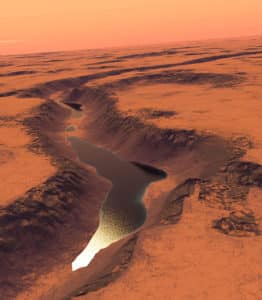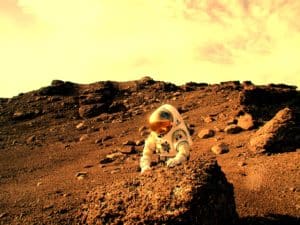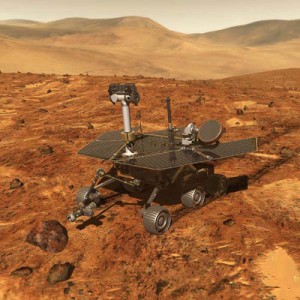Introduction: Mars; The History of Studies are Endless
As early as 300BC, Egyptians have referred to Mars as “Horus of the Horizon”. From the beginning that this massive red rock that boarders the  terrestrial planets in their orbit around The Sun has been discovered, it has mystified and left civilians and mainly scientists wondering if there will ever be a chance that our neighboring planet will ever be set foot on by a human being living on our planet, Earth. Mars has been extensively researched and tested in the best of scientist’s ability and technology that was available to them at their point in history for hundreds of years. In 1894, The Lowell Observatory was established specifically to study Mars and all the wonders that our neighboring planet has to offer. As the years have passed and technology has improved, more and more information has been discovered about Mars and hypothesis made on if there was ever life on Mars, and if there could ever be life on Mars again. Photographs have been taken from high-tech telescopes and rationales have been made from the discovery of other objects in the heavens, such as Pluto, suggesting that Mars either had or could have life on its surface someday.
terrestrial planets in their orbit around The Sun has been discovered, it has mystified and left civilians and mainly scientists wondering if there will ever be a chance that our neighboring planet will ever be set foot on by a human being living on our planet, Earth. Mars has been extensively researched and tested in the best of scientist’s ability and technology that was available to them at their point in history for hundreds of years. In 1894, The Lowell Observatory was established specifically to study Mars and all the wonders that our neighboring planet has to offer. As the years have passed and technology has improved, more and more information has been discovered about Mars and hypothesis made on if there was ever life on Mars, and if there could ever be life on Mars again. Photographs have been taken from high-tech telescopes and rationales have been made from the discovery of other objects in the heavens, such as Pluto, suggesting that Mars either had or could have life on its surface someday.
Today in the 21st century, with technology even stronger and more sophisticated than ever, scientist’s have begun to take further steps to learn the mysteries of Mars and learn more about the possibility of bringing human beings to Mars someday. With the development of customized rovers, cameras, space shuttles and tools, the possibility of humans one day setting foot on Mars has grown larger, as well as learning the real history of Mars.
The possibilities in space travel, astronomy and even science in general are endless, if astronauts ever landed on Mars and were able to fully examine and test everything about the planet’s surface and over attributes. By setting foot on Mars, astronauts would be able to set up extensive equipment to test the ground, air and atmosphere of Mars as well as being a large step closer to the Jovian planets, which would allow for more in-depth and close up research of the outer planets as well as posing the possibility of setting up space stations on Mars to actually explore the Jovian planets by way of spacecraft. The landing and thorough research of Mars is our next step towards discovering the true mystery of our solar system, as well as our existence as humans beings.
Setting foot on Mars: Why Someday Mars may be in Our Reach
Mars, being the fourth planet from the sun, is relatively small, comparing more to the size of The Earth’s moon than to most other planets in the solar system. The Mass of Mars is 5.419 x 10 to the 23 kg, while its density is 3.93 grams per centimeter cubed. Mars is very rocky and contains mountains much larger than any mountain that can be found on earth, and in that case, the largest mountain ever discovered in our solar system. Mars’ largest being Olympus Mons, which is actually a volcano, being measured to be 15 miles in height and its diameter around, according to In Quest of The Universe, “could cover much of the area of Washington and Oregon.
There are a number of possible reasons in which leave hope in scientists to someday reach human contact with Mars. The weather on Mars ranges anywhere from 30 degrees Celsius during the day (which is a very livable temperature for human beings) to -135 degrees Celsius at night. The reason for this very large slide in temperatures during the days and evenings on Mars is the fact that Mars has a very thin
atmosphere, causing the insulation during night hours to be very little, if evident at all. With the little atmosphere that Mars contains, being 95% made up of carbon dioxide, the temperature on Mars simply cannot be moderated. But the very mild temperatures of 35 degrees Celsius
leaves a window of opportunity for scientists and astronomers alike, to possibly be able to withstand the temperatures on a more moderately warm day on Mars.
Scientists have also noticed that the escape velocity on Mars would be 5.03 km/s, which is actually less than half of Earth’s escape velocity,
which is 11,200 meters per second. This would allow for humans to be able to land on Mars, do all the studying that they needed to do, and then be able to take off back to Earth.
The hypothesis that there may have been life on the planet, Mars at some point in history has been proven relatively valid over the years.
Photos have been taken from cameras and satellites in space showing some forms of possible dried up canals on the surface of Mars, as well as smooth edges on rocks and cliffs in the canals, which suggests that water causing friction with the constant rubbing up against the edges of
rocks in the canals, could have been the cause for the smooth edges in the canals.
Although scientist’s have failed to discover present-day water on Mars, they have discovered and noted the observations of the past presence of
water that can be found in the rocks, minerals, and geologic landforms, particularly in those that can only form in the presence of water(marsrovers.gov).
The possibility of water once existing on Mars opens up a whole new door of ideas attaining to life on Mars. With water comes the existence of
plants, as well one key nutrient that human bodies, the only human-like prototype Earth knows about, need.
All this information that has been discovered about Mars in history has been convincing enough to scientists that there is a very good possibility that there was once life on Mars, and maybe even the possibility that someday, there could once again be life on Mars. Scientists studies have become much more extensive and progressive in recent years.
Challenges Scientists must Overcome
With the great opportunities sciences have noticed to discover more about Mars, the realization that there are also a lot of challenges for the study to be successful must be noticed. Challenges include the actual travel to Mars, the weather that they must withstand, the money it is going to cost, and the smooth landing that the air craft must made if it holds actual human beings.
Astronauts have actually never landed on a solid space past the moon. This challenge would require new equipment that would be needed as well as the knowledge of how to go through Mars atmosphere (the little atmosphere that there is) and successfully land on the planet(Noble).
Another issue, which I briefly discussed earlier, was the extremely fluctuating weather on the planet. It would be much easier for astronauts to commit to their studies if the weather on the planet was 30 degrees Celsius as opposed to negative 135 degrees Celsius. They would need to plan the correct times to conduct their mission, and be equipped with protection that can withstand extremely cold temperatures if need be. The spacecraft and any other equipment that they brought with them would also have to withstand the very cold temperatures that Mars poses.
Another issue that has more to do with politics than the actual space travel by scientists and astronauts is the money factor. Any space-experiment costs millions of dollars, let alone actual human contact and space travel to a never before visited planet. The research they would have to conduct and the finances that they would have to give to the project could cost more than any other space travel experiment ever known. The issue stands with the residents of the United States and the government of the United States. A lot of people are opposed to the amount of money The US puts into space travel in general, and feel that the money can go to better causes, such as the welfare of the poor in our country and protection of our country against terrorism. Opposers of using sufficient amounts of US funds on space travel complain that there are better ways to make our choices with the money that we have than to use it on space travel and exploration.
Another issue that astronauts and scientists need to consider is the actual landing on Mars and what types of obstacles they might face. Mars is  filled with craters and mountainous surfaces. They would need to study and figure out the exact place that they were going to land and be prepared with the equipment and landing gear that they have designed, in order to have a safe landing for the actual humans on the ship, and eventually a safe take off back to Earth as well.
filled with craters and mountainous surfaces. They would need to study and figure out the exact place that they were going to land and be prepared with the equipment and landing gear that they have designed, in order to have a safe landing for the actual humans on the ship, and eventually a safe take off back to Earth as well.
Recent Studies and Steps towards Human Contact
In order for astronauts to eventually be able to set foot on Mars, there are a number of research projects and studies that must be completed before “human contact” mission is even deemed plausible. Missions and research includes what scientists label as “fly-bys” of Mars, “Orbiters” of Mars, and the “Roving” of Mars.
“Fly-Bys” of Mars took place when we were just beginning our study on the solar system and mainly Mars. The first studies of Mars in space simply flew by Mars, taking numerous amounts of pictures on their way past. Flyby missions included the Mariner 3-4 and The Mariner 6-7, which took place in the 1960’s.
The first Mariner space craft flew past Mars on July 14, 1965, collecting the first close-up photographs of another planet. The pictures, played back from a small tape recorder on the plane, showed lunar-type impact craters, some of them frozen over from a very cold evening on Mars. The Mariner 4 spacecraft lasted three years in solar orbit, studying Mars’ solar wind environment and making coordinated measurements with Mariner 5, the second ship which was launched to Venus in 1967 (nasa.gov).
These missions served as a great stepping stone to the beginning of our extensive research of Mars. Although technology was definitely not where it is today, NASA used what they had for equipment and set the precedent for the mid 20th century on how space exploration should be conducted. The pictures taken have helped lead scientists to their next step in exploring Mars; “The Orbiters”.
Orbiters are satellites that NASA scientists have launched into space to orbit Mars and take in-depth pictures and take readings on Mars’ atmosphere and weather. The Orbiters that we have sent out have given us a number of different types of information about our neighboring planet. Orbiters have helped us learn about the craters, gullies and channels of Mars as well as the rocks and polar ice caps. Also, without these orbiters, such as the Mariner 8-9 and first and second Viking, we may have never been able to obtain the extensive amounts of information on Mars’ landforms, internal structure, magnetic field and the elemental and mineral composition.
Recently, orbiters have helped to obtain information in preparation for our newest type of exploration on Mars, Rovers. For example, the satellites we have orbiting Mars have helped find appropriate spots to land are rovers safely, without any serious damage being inflicted on the machines before they even begin their research.
Satellites (orbiters) have been working hand in hand with Rovers, which will be explained next, to help identify “scientifically interesting sites” on Mars that rovers should study. That satellites lend a huge helping hand to the rovers, who’s controllers need to be focused on avoiding hazardous terrain, by aiming their antennas towards earth to translate the information on rocks and dirt that the rovers are picking up, and send the signals back to Earth for more in-depth, hands on studies.
Orbiters will also be a large help with the incoming space crafts containing further equipment, by assisting with the navigation for correct insertion into the orbit of Mars, as well as a smooth landing.
Lastly, orbiters are very helpful in the return of information studied on Mars, back to Earth. A strategy NASA has most recently used is launching the information found into Mars’ orbit in a small canister for the satellite to pick up and bring back to Earth.
The latest technology has allowed us to actually land on Mars and travel the planet via “a rover”. The rovers we have sent to Mars are actually inflatable. Which use very large, inflated wheels to move over rocks, as opposed to having to go around them and waste time. Rovers are built to be inflated upon arrival at Mars and deflated into a much more compact and light-weight piece of equipment to board the ships and return to Earth. Rovers now rely on state-of-the-art technology to know where they are on Mars and which rock and dirt samples are worth testing.
Eventually, NASA’s goal is to have teams of rovers roaming the planet, that can meet up and exchange information to eventually be sent to Earth for testing. NASA’s overall goat with the Rovers is to get them working to the point where they could even build a robotic colony and set up places for humans to land and live while they are on their journey. NASA has stated that if humans indeed to someday reach Mars, that rovers will act as a tool to “pave the way” for human contact.
Other Essential Equipment being used:
The large equipment, such as the satellites and rovers have done wonders for the experimentation on Mars, but there are various types of other equipment that we have used and plan on eventually using when the time comes that our own human feet are actually setting foot on Mars. This equipment includes special cameras, spectrometers, grinders and magnets.
The Panoramic Camera, nicknamed “the pancam”, is a pair of cameras with extremely high resolution that will be used to view both the land  and sky of Mars. These cameras can be hand-held, but right now scientists have attached them on top of the rovers, in order to get the most hands on experience they can while still sitting in their laboratories on Earth. Each pancam has a special lens that allows images to be taken at different wavelengths, which helps scientists on Earth examine the rocks and gravel found to a greater extent.
and sky of Mars. These cameras can be hand-held, but right now scientists have attached them on top of the rovers, in order to get the most hands on experience they can while still sitting in their laboratories on Earth. Each pancam has a special lens that allows images to be taken at different wavelengths, which helps scientists on Earth examine the rocks and gravel found to a greater extent.
The other type of camera that NASA is using is The Microscopic Imager, which can view rocks at an even closer view than The Panoramic Camera. This camera is specifically made to look for signs of the rocks interacting in any way, shape, or form with water that may have exited on Mars at any point. This camera does so by analyzing the size, shape and indentation on each rock that it views. This tool has also recently been added to the rover’s arsenal, as the camera can be attached to its arm.
Another type of tool that has just recently been used on Mars is The Miniature Thermal Emission Spectrometer, in short, the Mini-TES. This scopes our rocks and reads the thermal radiation signals that rocks on Mars emit. By finding out the thermal radiation patterns of the rocks found, scientists are able to figure out which types of minerals are found on Mars. With this information, they compare and contrast their finding to already-known information on rocks and their nature-involvement with water; again searching for proof that water could once be found on Mars.
The last tool that I will speak of is The Rock Abrasion Tool, the RAT (how clever). The RAT is small and compact, but is designed to drill approximately two inches into rock formations found on Mars. Scientists use this tool to expose the insides of a rock, which may or may not be different than the outside of the rock. If it is found that the insides of the rock are different than the outsides, than scientists can study this and see what types of “environmental conditions” would have caused the outside of the rock to be different than the inside. This alone can help scientists discover what the environment on Mars was once like.
Conclusion: What does NASA have Planned for The Future?
With all the work that has been completed in the past five years, taking one step closer to discovering the mystery of Mars, NASA is only looking ahead towards the future. In late 2005, NASA plans to send orbiters into the orbit of Mars to study the temperature and overall weather of Mars, as well as continuing to search for signs of water. This mission is scheduled to last approximately one year.
In 2007, NASA plans to send a team of four rovers to different locations on Mars so that they can all collect data on Mars’ rocks, atmosphere and internal structure at the same time. They will be using an orbiter as a reconnaissance tool, to help organize the navigation of the mission, as well as relay their findings back to Earth for further studies.
Given the steps that NASA has taken in the most recent years to improve their technology and fully explore our neighboring planet, the mystery of Mars is surely within our grasp. Although plans for actual human contact have not been made, we should expect them to be made sometime in the immediate future. We began our exploration of Mars with “drive-bys” and proceeded with orbiters. We now have vehicles fully exploring Mars with high-tech cameras giving scientists on Earth a clear site to everything the rover sees. Recently, NASA has released their plans to build a robotic space station on Mar’s; could humans be next?
Bibliography
Lowell, Percival. “Mars”. Boston, New York, Houghton, Mifflin and Company, 1895
Lowell, Percival. “Mars and its Canals.” Boston, New York, Houghton, Mifflin and Company, 1895
Wilford, John Noble. “Mars Beckons: the mysteries, the challenges, the expectations of our next great adventure in space” New York: Knopf, 1990
Mars Exploration Rover Mission. Updated Regularly by NASA. http://marsrovers.jpl.nasa.gov
“Mars Timeline of Discovery” May, 2001. Astrodigital Inc. http://www.astrodigital.org/mars/index.html

